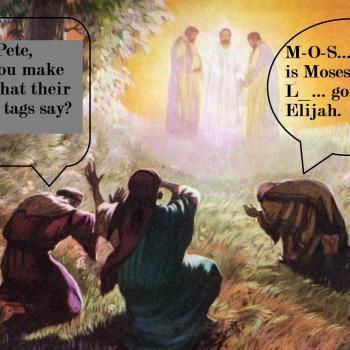Three articles in very different venues, on very different topics, grabbed my attention for what they can help us to understand and reflect on when it comes to the quest for the historical Jesus. The first is in Christian Century, and it offers a contrast as well as advocating for a change by pointing out that there is no “quest for the historical Mr. Rogers.” The Fred Rogers of history is not a precise match with the person depicted in the recent Tom Hanks movie, or the article that inspired it, or anywhere else. Yet he inspires. Historians of course know this, and Christians who look at historical research about Jesus know that there is regularly a disconnect between the historical Jesus and the one from whom Christians take inspiration and their pattern for life. The question is whether that is fine, and I think the appropriate answer is “yes and no.” No one finds a model in another human being as they really are with no distortions. On the other hand, simply being deluded about any other person can cause problems when we take them as a model. And so there is a place for historical investigation, and for going beyond the limits of what history can tell us.
Next let me share what Matt Reed wrote about Martin Luther King Jr. as part of a tribute to John Lewis:
American culture is very good at pretending that people who were controversial in their time were actually universally loved and respected after they’re gone. That’s especially true of leaders in the fight for equality. Dr. Martin Luther King, to take the obvious example, was a polarizing figure in his time. Over time, he became a democratic socialist; although you wouldn’t know it from the way his birthday is celebrated, in his final years he led a “poor people’s campaign” for economic justice. I remember being struck, the first time I read “Letter from a BIrmingham Jail,” that he seemed more frustrated by “white moderates” than by avowed racists. With the latter, at least the battle lines were clear. With the former, all of the “yes, but…” answers, the “this is not the right time” or “that’s not the right way to protest” answers, the issues got cloudier. That made them harder to solve.
That “moderate” tendency is behind the move to sand down his rougher edges, and turn him into an uncomplicated man with an uncomplicated cause. In high school in the 80’s, I heard about segregated schools and lunch counters (although only in the South); I didn’t hear a whiff of his economics until college, and even then, only in the context of a course on protest movements. The story I learned in most of high school, and this is only a slight exaggeration, was “there was slavery, and that was bad, but the civil war solved it. Then there was racism, and that was bad, but Martin Luther King solved it. The End.”
Turning King into a Disney cartoon isn’t remembering the actual historical figure. It leaves out the work he considered undone. It also implies by contrast that anyone who generates controversy now must be somehow lesser or wrong, because otherwise they’d be universally beloved. They’re not, so they must be flawed in some unprecedented way.
So much of what he says can be applied equally well to Jesus. Last of the three, Prof. Stephanie Johnson wrote about the discomfort that a certain brand of fan can have with adaptations based on their beloved characters or stories. What she says there about Sherlock Holmes also applies to Jesus.
Let me also add here a mention of an article by Yardenna Alexandre in the latest issue of ‘Atiqot which documents archaeological evidence from Nazareth through the time of Jesus. There is an interview with Alexandre in the Times of Israel. Yes, even more evidence has amassed against the already-disproven view of armchair archaeological pontificator René Salm. HT Tim O’Neill on Twitter:
Oh dear – poor Rene “Piano Man” Salm’s crackpot theory that Nazareth didn’t exist in Jesus’ time has more peer-reviewed expert evidence to contend with. Y. Alexandre has published her latest findings in *’Atiqot* – (see update at the end of my article):https://t.co/ms9rr7GM5P
— Tim O’Neill (@TimONeill007) July 22, 2020
See also:
https://scribesofthekingdom686237748.wordpress.com/2020/07/19/some-hard-sayings-of-jesus-amputation/
Dr. Sung Yuk Kim on the Synoptic Gospels
See too Helen Bond’s multi-part conversation with Ben Witherington. In one segment Bond says:
I’d put Mark in Rome in the 70s; I think he’d seen the Flavian triumph and incorporates features of it into his account of Jesus’ ‘procession’ to Calvary. But I’m also more open to the idea that Mark had some connection with Peter than most critical scholars tend to be – for me, it helps to make sense of why Mark’s work became popular so quickly. But even if he did have a certain amount of good material from Peter, the great apostle had died almost a decade earlier, well before some of the difficulties that Mark’s audience would have faced. So I think there is good historical material here, but it’s all packaged up into a distinctive literary form which focusses far more on Jesus than on secondary characters.
Finally, for those who may be interested, Mark Bilby is continuing his mimetic exploration of a hypothetical reconstructed New Testament source, which he believes depicts Jesus as a “new Aesop” and which he thinks, as a result, allows for points of connection and comparison or contrast to become part of the meaning. You might want to start with Was Jesus a Slave? in which he responds to my earlier mention of this project of his. See also:
https://vocesanticae.com/2020/07/14/mary-magadalene-in-qn-was-the-baptists-follower-then-the-messenger-of-malachi-3-1/
https://vocesanticae.com/2020/07/18/summary-highlights-of-the-first-gospel-qn-50-65/
https://vocesanticae.com/2020/07/18/transfiguration-in-qn/
https://vocesanticae.com/2020/07/18/the-first-great-parable-in-the-jesus-tradition-dives-and-lazarus/
https://vocesanticae.com/2020/07/17/the-earliest-form-of-the-lords-prayer-qn/
https://vocesanticae.com/2020/07/17/gospel-of-marcion-was-not-based-on-canonical-luke/
https://vocesanticae.com/2020/07/16/no-bandits-crucified-with-jesus-in-the-earliest-gospel-or-on-biased-ellipses/













